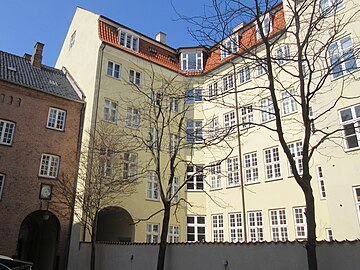
Brøste House, also known as Potter House after its founder, Thomas Potter, a Scottish born industrialist, is a late 18th-century historic property at Overgaden Oven Vandet 10, overlooking Christianshavn Canal, in the Christianshavn neighbourhood of Copenhagen, Denmark. The building was listed in the Danish registry of protected buildings and places in 1918. It is now owned by Barfoed Group.
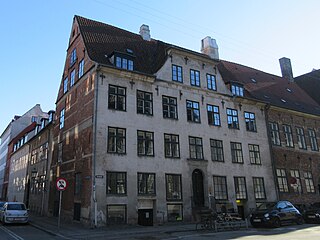
The Mikkel Vibe House is a historic property located at Strandgade 32 in the Christianshavn neighbourhood of Copenhagen, Denmark. It is believed to be the oldest building in Christianshavn and takes its name after Mikkel Vibe who was mayor of Copenhagen.

The Schottmann House Danish: is a historic property located at Strandgade 10 in the Christianshavn neighbourhood of Copenhagen, Denmark.

Nyhavn 13 is a historic townhouse overlooking the Nyhavn Canal in central Copenhagen, Denmark. With roots dating back to the late 17th century, it owes its current appearance to a heightening of the building with two floors in 1842. Notable former residents include the businessman Abraham Marcus Hirschsprung and the painter and educator Wilhelm Kyhn. The building was listed in the Danish registry of protected buildings and places in 1945.

Overgaden Neden Vandet 33 is a residential property in the Christianshavn neighborhood of central Copenhagen, Denmark. It is one of three properties along with Christianshavn Canal that were built by anchor smith Hans Caspersen and are now known as the Hans Caspersen House, the other being Overgaden Oven Vandet 50 and Overgaden Neden Vandet 33. The building at Sankt Annæ Gade 4 is also associated with Caspersen. The building was listed on the Danish registry of protected buildings and places in 1918.

Vingårdstrøde 19 is a Neoclassical property situated on Vingårdstræde, between Kongens Nytorv and Nikolaj Plads, in central Copenhagen, Denmark. Like most of the other buildings in the area, the building was constructed as part of the rebuilding of the city following the Copenhagen Fire of 1795. It was listed in the Danish registry of protected buildings and places in 1959. A number of people associated with the Royal Danish Theatre have resided in the building, including ballet dancers and choreographers Antoine Bournonville, August Bournonville and Carl Dahlén, as well as a number of members of the Royal Danish Orchestra. Other notable former residents include future cookbook writer Anne Marie Mangor, portrait painter Johan Frederik Møller and sculptor Daniel Peter Støhrmann.

Toldbodgade 5 is a 17th-century property situated in Toldbodgade, off Nyhavn in central Copenhagen, Denmark. It was listed in the Danish registry of protected buildings and places in 1977. The composer Carl Nielsen and the sculptor Anne Marie Carl-Nielsen resided in the apartment on the first floor from 1898 to 1906.

Overgaden oven Vandet 54–56 is a complex of Late Neoclassical buildings situated at the corner of Overgaden Oven Vandet and Bådsmandsstræde, adjacent to Søkvæsthuset, in the Christianshavn neighborhood of central Copenhagen, Denmark. The two buildings originate in a two-storey bourgeois townhouse from the first half of the 18th century but were both heightened to five storeys by silk hat manufacturer and developer H.P. Lorentzen in the 1840s. The two buildings were individually listed in the Danish registry of protected buildings and places in 1945.

Torvegade 22 is an 18th-century property situated on Torvegade in the Christianshavn neighborhood of central Copenhagen, Denmark. The building was from its construction in 1714 to 1902 owned by bakers and the site of one of two bakeries in the street. A gilded kringle can still be seen above the main entrance. The other bakery was situated a little further down the street at Torvegade 28. The building was listed in the Danish registry of protected buildings and places in 1950.
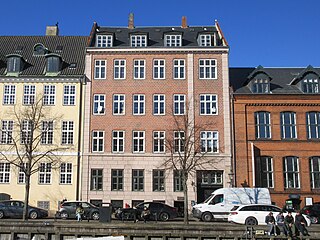
Overgaden Neden Vamdet 15 is a mid-19th-century property overlooking the Christianshavn Canal in the Christianshavn neighborhood of central Copenhagen, Denmark. It consists of an L-shaped building with high-end apartments from 1858 fronting the street and an older rear wing now used as office space, ateliers and storage space. The two buildings were both listed in the Danish registry of protected buildings and places in 1980. Notable former residents include the businessman Peter Heering and the author Henrik Pontopidan.

O – Overgaden, or simply Overgaden, is a non-profit contemporary art venue situated at Overgaden Neden Vandet 17 in the Christianshavn neighbourhood of central Copenhagen, Denmark. It hosts approximately eight major exhibitions each year. Constructed in 1887 to designs by Frederik Bøttger, an architect who also worked for Arbejdernes Byggeforening, Overgaden Neden Vandet 17 was originally built for a charity as a public dining facility. In 1893, it was acquired by C. Ferslew & Co. and converted into a printing workshop under the name Centraltrykkeriet. In 1936, it was expanded with a large funkis-style extension on the rear. The art centre opened in 1986. The building was together with Wildersgade 20 on the other side of the block listed in the Danish registry of protected buildings and places in 1989. The extension from 1936 is not part of the heritage listing.
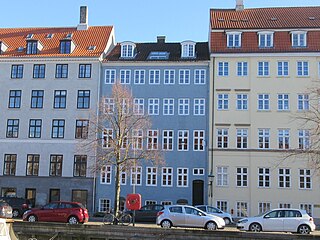
Ovengaden Oven Vandet 52 is a mid 19th-century residential building overlooking Christianshavn Canal in the Christianshavn neighborhood of central Copenhagen, Denmark. The building was constructed in 1772 but heightened in 1846. It was listed in the Danish registry of protected buildings and places in 1945. Notable former residents include the botanist Erik Viborg, diplomat and politician Valdemar Rudolph von Raasløff and painter Edvard Weie.

Overgaden Oven Vamdet 20 is a canal house overlooking Christianshavn Canal in the Christianshavn neighborhood of central Copenhagen, Denmark. Built for a former ship captain in 1802, it stands four storeys tall and just three bays wide. It was listed in the Danish registry of protected buildings and places inn 1918. Notable former residents include the zoologist Jørgen Matthias Christian Schiødte.
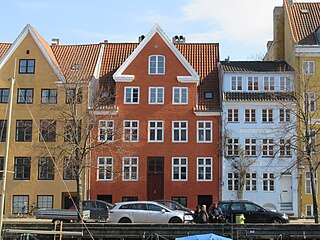
Overgaden Oven Vandet 24 is an 18th-century property overlooking Christianshavn Canal in the Christianshavn neighborhood of central Copenhagen, Denmark. It was listed in the Danish registry of protected buildings and places in 1945. Notable former residents include the politician Asmund Gleerupl.
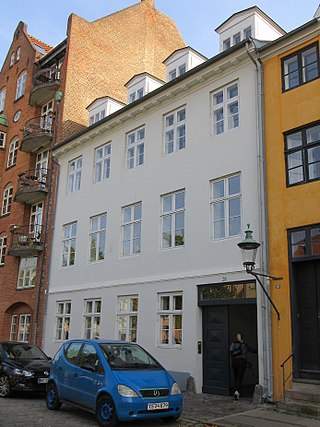
Overgaden Oven Vandet 28 is an 18th-century property overlooking Christianshavn Canal in the Christianshavn neighborhood of central Copenhagen, Denmark. It was listed in the Danish registry of protected buildings and places in 1945. Notable former residents include publisher Frederik Hegel and painter Heinrich Hansen.

Overgaden Neden Vandet 31 is an 18th-century canal house overlooking Christianshavn Canal in the Christianshavn neighbourhood of central Copenhagen, Denmark. It was listed in the Danish registry of protected buildings and places in 1918.

The Gerling House is a late 17th-century hibuilding complex complex situated at Strandgade 38 in the Christianshavn district of central Copenhagen, Denmark. It consists of a three-storey, four-bays-wide front wing towards the street and a 13-bays-long two-storey side wing on its rear. The master cooper Peter Richter established a cooper's workshop in the building in the 1830s and the property was after his death owned by his widow until 1880. The building was listed in the Danish registry of protected buildings and places in 1918. Notable former residents include the naval officer and painter Sophus Schack.
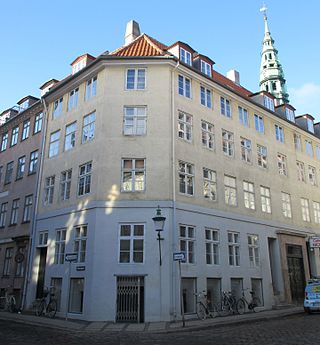
Nikolajgade 20 / Dybensgade 20 is a Neoclassical apartment building situated at the corner of Nikolajgade and Dybensgade in central Copenhagen, Denmark. The building was constructed by master mason Anthon Christian Wilcken and master carpenter Andreas Hallander in 1799–1800 as part of the rebuilding of the city following the Copenhagen Fire of 1795. It was listed on the Danish registry of protected buildings and places in 1959. A young Hans Christian Andersen was the lodger of a widow on the second floor in the early 1820s. From 1825 to 1840 the building was operated as a home for indigent seamen under the name Bombebøssen. That institution—founded by the naval officer Peter Norden Sølling in 1819—was then moved to Christianshavn. The building at the corner of Nikolajgade and Dybensgade was hit by fire in 1855 but subsequently restored.
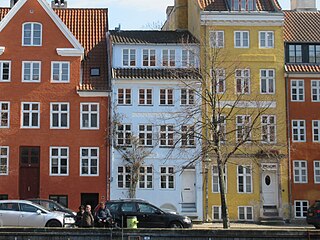
Overgaden Oven Vamdet 22 is a 17th-century building overlooking Christianshavn Canak in the Christianshavn neighbourhood of central Copenhagen, Denmark. It was listed in the Danish registry of protected buildings and places in 1945.
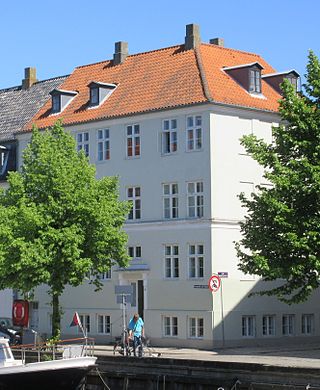
Overgaden Oven Vamdet 8 is an 18th-century building overlooking Christianshavn Canal in the Christianshavn neighbourhood of central Copenhagen, Denmark. It originates in a two-storey, Neoclassical building constructed in 1786 by Andreas Kirkerup for candle maker Christian From. This building was heightened with one storey in 1831. It was listed in the Danish registry of protected buildings and places in 1945. Notable former residents include organist and composer Niels Peter Hillebrandt.








